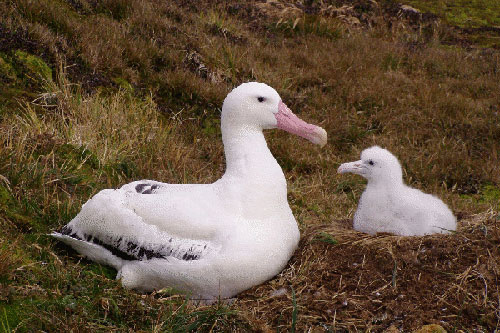Deborah Pardo (British Antarctic Survey, Cambridge, United Kingdom and ACAP’s European News Correspondent) and colleagues write open-access in the journal Ecology and Evolution on ageing in Wandering Albatrosses Diomedea exulans.
The paper’s abstract follows:
“Allocation decisions depend on an organism’s condition which can change with age. Two opposite changes in life-history traits are predicted in the presence of senescence: either an increase in breeding performance in late age associated with terminal investment or a decrease due to either life-history trade-offs between current breeding and future survival or decreased efficiency at old age. Age variation in several life-history traits has been detected in a number of species, and demographic performances of individuals in a given year are influenced by their reproductive state the previous year. Few studies have, however, examined state-dependent variation in life-history traits with aging, and they focused mainly on a dichotomy of successful versus failed breeding and nonbreeding birds. Using a 50-year dataset on the long-lived quasi-biennial breeding wandering albatross, we investigated variations in life-history traits with aging according to a gradient of states corresponding to potential costs of reproduction the previous year (in ascending order): non-breeding birds staying at sea or present at breeding grounds, breeding birds that failed early, late or were successful. We used multistate models to study survival and decompose reproduction into four components (probabilities of return, breeding, hatching, and fledging), while accounting for imperfect detection. Our results suggest the possible existence of two strategies in the population: strict biennial breeders that exhibited almost no reproductive senescence and quasi-biennial breeders that showed an increased breeding frequency with a strong and moderate senescence on hatching and fledging probabilities, respectively. The patterns observed on survival were contrary to our predictions, suggesting an influence of individual quality rather than trade-offs between reproduction and survival at late ages. This work represents a step further into understanding the evolutionary ecology of senescence and its relationship with costs of reproduction at the population level. It paves the way for individual-based studies that could show the importance of intra-population heterogeneity in those processes.”

An old Wanderer guards its chick, photograph by John Cooper
Click here to access earlier publications by Deborah Pardo on ageing in albatrosses, including her PhD thesis on the subject.
Reference:
Pardo, D., Barbraud, C. & Weimerskirch, H. 2014. What shall I do now? State-dependent variations of life-history traits with aging in Wandering Albatrosses. Ecology and Evolution doi: 10.1002/ece3.882.
John Cooper, ACAP Information Officer, 31 January 2014

 English
English  Français
Français  Español
Español